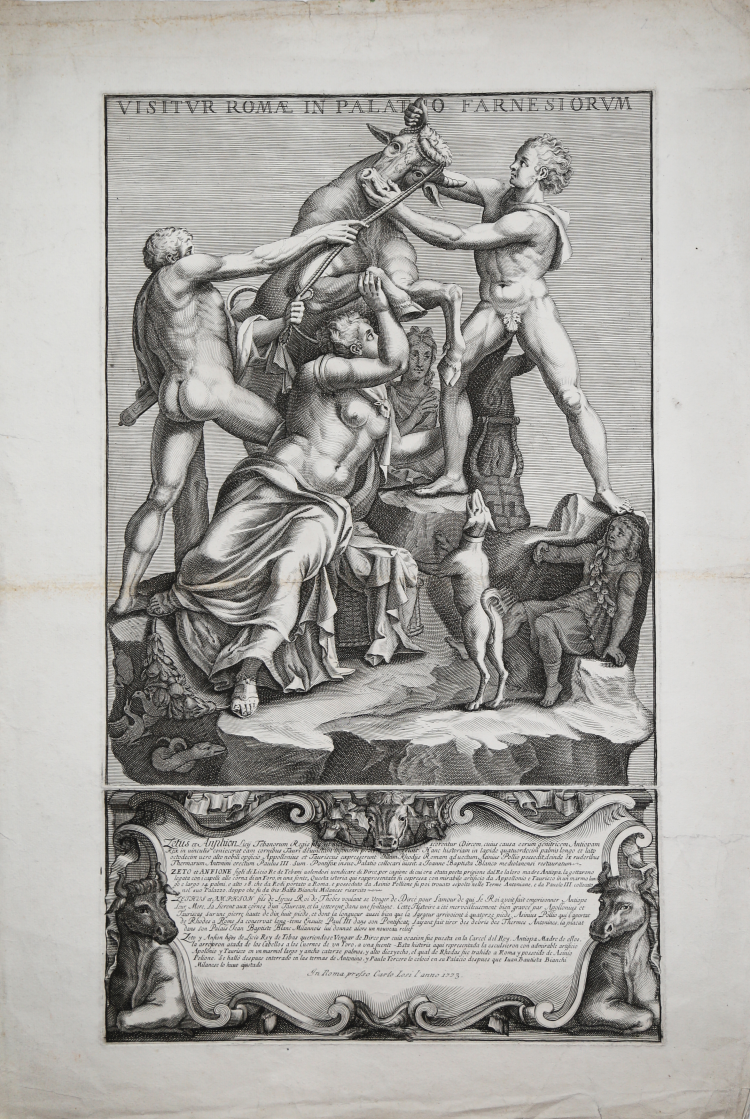



| Reference: | S40601 |
| Author | Pietro Paolo GIRELLI |
| Year: | 1680 ca. |
| Measures: | 350 x 600 mm |


| Reference: | S40601 |
| Author | Pietro Paolo GIRELLI |
| Year: | 1680 ca. |
| Measures: | 350 x 600 mm |
Etching, 1680 circa, lettered along the upper edge VISITUR ROMAE IN PALATIO FARNESIORUM; in lower margin, in an elaborate cartouche, a caption in Latin, Italian, French and Spanish.
The composition is printed from two plates: the first one (cm 353 x 443) for the Farnese Bull, the second plate for the cartouche. The first edition was published at the end of XVII Century by Matteo Gregorio de Rossi; we asscribed the plate to Pietro Paolo Girelli for stylistic reason.
The present example bears the Carlo Losi’ address: “In Roma presso Carlo Losi l’anno 1773”.
Both edition are extremely rare.
The group has been massively restored as a scene of the Punishment of Dirce, as she is being tied to a bull, an act performed by Zethus and Amphion. Pliny mentions such a group created by Apollonius and Tauriskos, adopted Rhodians of the first century B. C, which could be seen in Rome in his day. The Farnese Bull may be a copy of this work, created in the early third century A.C. for the Baths of Caracalla. The work was discovered in the course of excavations for Pope Paul III in the Baths of Caracalla in 1545. The restoration, made with advice from Michelangelo, was evidently a slow process. When Aldravandi saw the work in 1550 in the Palazzo Farnese, it had only the bull and one of the male figures (which Aldrovandi identified as He cules ) . By 1585 the restoration was complete, as may be seen in the engraving of the group published that year by G. B. de ' Cavalieri. By this time the subject had been identified as the Punishment of Dirce . The influence of the group was great. It has been recognized in the Rape of Europa (1559-1662) by Titian and the Rape of the Daughters of Leucippus (ca. 1618) by P. P. Rubens. The painter Federico Zuccaro described the Farnese Bull as a " marvellous mountain of marble " and ranked it as the greatest ancient sculpture surviving, along with the Laocoon. This opinion is astonishing in the light of the near obscurity of the work today, but, in fact, until the nineteenth century, many who saw it had a similar evaluation. Louis XIV was among those who admired the Bull; he tried, unsuccessfully, to buy it in 1665. In the eighteenth century, Ficoroni deduced that the Farnese Bull was a Roman copy, an astute observation for the time, but Winckelmann denied this, declaring, instead, that it was Greek , of the period after Alexander the Great . There was much debate over the degree of restoration of the sculpture, with a corresponding vacillation in critical reaction. The statue was moved to Naples in 1786 and stands today in the Museo Nazionale in Naples, facing the Farnese Hercules.
A fine impression, printed on laid paper, wide margins, very good condition.
|
Sconosciuta ai repertori.
|
Pietro Paolo GIRELLI (Attivo a Roma fine XVII secolo)
|
Peter Paul Walker is an engraver of views, perspectives and custom architectures, active in Rome in the workshop of Matteo Gregorio de Rossi. His main work is the great map of Lazio in 6 sheets, edited by Giovanni Battista Cingolani.
His main work is the great map of Lazio in 6 sheets, edited by Giovanni Battista Cingolani.
|
|
Sconosciuta ai repertori.
|
Pietro Paolo GIRELLI (Attivo a Roma fine XVII secolo)
|
Peter Paul Walker is an engraver of views, perspectives and custom architectures, active in Rome in the workshop of Matteo Gregorio de Rossi. His main work is the great map of Lazio in 6 sheets, edited by Giovanni Battista Cingolani.
His main work is the great map of Lazio in 6 sheets, edited by Giovanni Battista Cingolani.
|